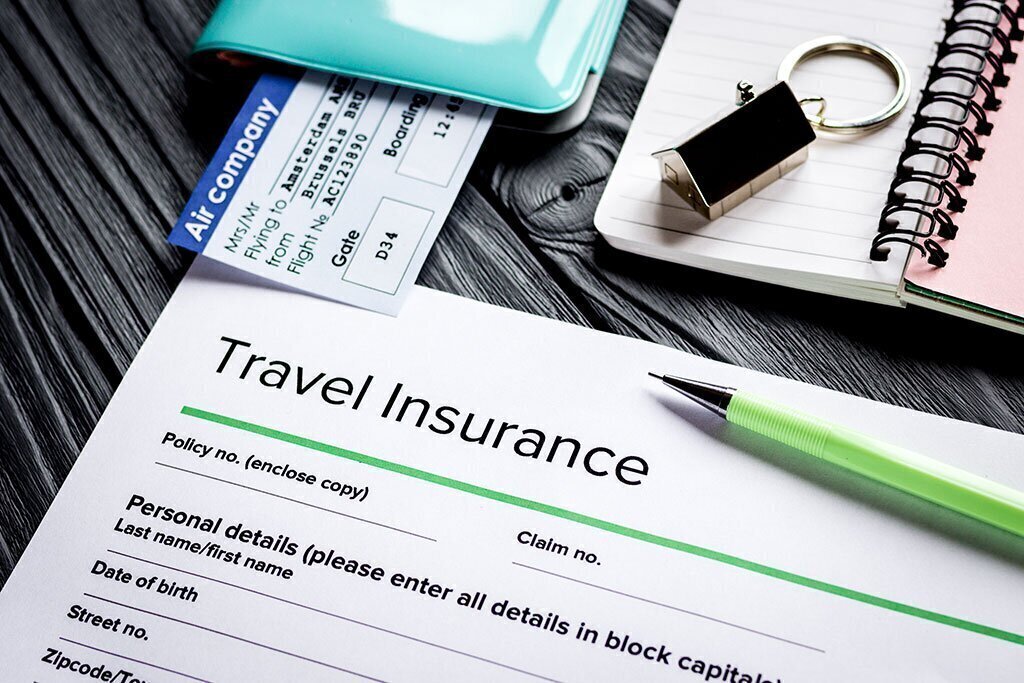Last updated July 2022
Do You Need Travel Insurance?
(Spoiler: For Most Trips, Probably Not)
After the COVID-19 pandemic ruined so many vacations, travelers rightfully worry about plunking down thousands of dollars to make new plans—especially since so many airlines, vacation property owners, tour operators, and their ilk were stingy about issuing refunds.
Even before COVID, airlines and travel booking companies had manufactured ways to “protect” customers from their own cruel cancellation and refund policies: travel insurance plans. Because airlines and booking sites get a big cut of each purchase, they give the hard sell on these policies. And their customers are biting: In 2022, travelers will spend more than $20 billion on such insurance, up from $2.8 billion in 2016.
 Several types of travel insurance are available: trip interruption and cancellation; cancel-for-any-reason; and, for international travel, coverage for medical expenses and evacuation. There are also hybrid plans that combine different coverages.
Several types of travel insurance are available: trip interruption and cancellation; cancel-for-any-reason; and, for international travel, coverage for medical expenses and evacuation. There are also hybrid plans that combine different coverages.
Are travelers getting something of value or just getting taken for a ride?
In this article, we share our buying advice on each type of coverage. A boiled-down version for impatient readers:
- Trip interruption and cancellation policies pushed by airlines, travel-booking sites, cruise lines, etc., provide skimpy coverage and are lousy deals. Don’t buy them.
- Cancel-for-any-reason plans, available from several travel insurance websites, offer far better coverage but are expensive, and most don’t fully reimburse trip costs. Before buying one, evaluate how much money you’d lose by canceling a trip and whether or not you can live with that loss. Know that most travelers don’t risk much: For most trips, you can cancel and get some or all of your money back (or postpone your holiday and rebook later with little or no penalty).
- It makes sense for some international travelers to buy medical insurance policies, especially if they are Medicare beneficiaries (no coverage for foreign healthcare costs) or visiting regions that lack comprehensive medical facilities, and their health insurance plans don’t cover the high price of medical evacuation.
Read on for details on what to buy (if anything) before going buh-bye.
DON’T BUY…
Trip Interruption and Cancellation Policies Sold by Airlines and Travel Booking Websites
When buying a plane ticket online, United urges “Don’t ignore the unexpected” by offering to “Add valuable coverage for your flight.” American Airlines also pushes its trip insurance (“Recommended”). Delta declares its coverage to “protect your trip” is “Highly Recommended,” and adds this supporting authoritative quote from a Forbes article: “In these trying travel times, purchasing travel insurance should be commonplace.”
Booking websites like Orbitz also push trip insurance. Orbitz even includes a testimonial from “Mary,” a former customer who got a refund after canceling her trip to care for her sick husband. (Oh, Mary, you saint!)
All require that you click “No” before proceeding with your purchase. Do so and they’ll warn of impending doom. United makes you agree that, by declining coverage, you acknowledge that “you may otherwise be responsible for certain cancellation fees.” (In other words, United surreally is urging its customers to buy insurance to protect themselves from its own bad policies.)
 Most of the policies sold by airlines and booking sites promise to cover:
Most of the policies sold by airlines and booking sites promise to cover:
- Reimbursement of otherwise nonrefundable prepaid costs if you cancel your trip due to unforeseeable covered reasons, which typically include illness, death, or involuntary loss of employment.
- Reimbursement if you or a traveling partner cancel or get delayed due to a positive COVID-19 test result.
- Reimbursement if you have to cancel to stay home to care for a hospitalized family member.
- Reimbursement of fees paid to a travel company that goes out of business.
- Increased costs if you miss a flight or connection for reasons beyond your control (weather, car accident, etc.).
- Increased costs if you have to interrupt your trip and go home early due to a medical reason or a medical crisis or death in your family.
- Delayed, lost, or damaged baggage.
Although fairly inexpensive (they’re usually priced from $15 to $75 per passenger, depending on the cost and length of the trip), these plans are nearly always bad buys. While such benefits might make these policies seem like sensible add-ons, click a few links to wade into the fine print and you’ll find long lists of limitations and exclusions. For example, American Airlines’ website says its policy protects flyers from many types of perils, but—like other carriers and booking websites—inadequately discloses dozens of gotchas. For American, we had to download a 34-page PDF to learn:
- The policy won’t pay up if you cancel your trip due to—among many circumstances—an illness caused by a preexisting medical condition, pregnancy, or childbirth; an epidemic other than COVID-19; a “mental or nervous health disorder,” which includes “anxiety, depression, neurosis, psychosis, or any related physical symptoms”; the “use or abuse of alcohol or drugs” (could just one margarita disqualify you?); “war or acts of war”; “civil disorder or unrest”; “terrorist events”; “air, water, or other pollution”; “participating in or training for any amateur sporting competition while on your trip”; or—and this seems a catchall excuse to deny any claim—“any loss, condition, or event that was known, foreseeable, intended, or expected when your policy was purchased.”
- The policy also excludes travel to areas for which “any government or public authority” has issued “travel alerts/bulletins.” This is also a biggie: According to the guidance and alerts posted on the U.S. State Department website, very few corners of the Earth are safe.
- Run into trouble and you’ll have to pay to get yourself out of it—and then submit claims for reimbursement (cross those fingers!). You’ll need notes from doctors and other painful-to-obtain paperwork to prove you or a companion were too sick to travel, or that a death occurred back home, or maybe that your injury occurred while running but not during a race, and so on.
- You gotta submit any claims right away, as quickly as within 24 hours if your luggage is damaged, for example.
- There are payout limits—for example, maximum “$500 in total for all jewelry, watches, gems, furs, cameras, and camera equipment, camcorders, sporting equipment, computers, radios and other electronic items,” and you’ll have to provide original receipts (LOL, yeah, right!) for each item if you want full reimbursement. Don’t have receipts? Policies usually limit payouts to $100 for lost and stolen baggage.
- If you are delayed, the insurance reimburses a maximum of only $250 a day for up to five days for accommodations and expenses.
That’s a slew of exclusions and limitations for insurance advertised as providing “total protection.”
In 2018, the office of Senator Edward Markey (D-Mass.) released a study on travel insurance declaring, “The only thing skimpier than airplane legroom are these travel insurance plans.” After studying plans offered by 16 airlines and travel-booking websites, his report concluded that while “being aggressively pushed onto customers…offered travel insurance fails to provide promised coverage, and…the airline industry is exploiting travel insurance as an easy revenue generator.”
We often advise consumers to buy insurance only to protect against risks that could be financially catastrophic. For most, losing the value of airfare wouldn’t be financially catastrophic. And there’s a low risk of any loss, anyway, especially as long as airlines continue to allow passengers to make changes for free. Also keep in mind that if an airline cancels your flight it must provide a refund, if you request one. In some parts of the world, including the E.U., airlines must provide passengers additional financial compensation for delays.
Another sign that trip cancellation insurance isn’t worth much: Some credit cards offer customers similar coverage as a free perk.
DON’T BUY…
Cancel-for-Any-Reason Coverage (Unless It’s an Unusual Trip)
While cancel-for-any-reason plans offer good coverage, especially when compared to the lousy stuff sold by airlines and travel booking sites, we still think they’re usually wasteful buys.
Websites such as InsureMyTrip.com, QuoteWright.com, and SquareMouth.com sell these plans, which promise to pay back any nonrefundable costs if you cancel a trip. A key word here is “nonrefundable”: If you’re entitled to a refund of any prepaid costs or can get a voucher or credit toward a future trip, that’s not covered. And most plans also require that you cancel more than 48 hours before your scheduled departure. In other words, if you cancel the day before or day of your trip, the insurer won’t pay up.
 These policies aren’t cheap: They’re typically priced at 10 to 20 percent of the total trip cost. And many plans cover only a portion (typically 50 or 75 percent) of covered costs. When we shopped for a cancel-for-any-reason policy to cover a fully-paid-in-advance two-week trip to Spain costing $15,000, we found prices on SquareMouth.com ranged from $1,194 to $2,538; at InsureMyTrip.com, prices ranged from $1,616 to $2,165.
These policies aren’t cheap: They’re typically priced at 10 to 20 percent of the total trip cost. And many plans cover only a portion (typically 50 or 75 percent) of covered costs. When we shopped for a cancel-for-any-reason policy to cover a fully-paid-in-advance two-week trip to Spain costing $15,000, we found prices on SquareMouth.com ranged from $1,194 to $2,538; at InsureMyTrip.com, prices ranged from $1,616 to $2,165.
Before buying insurance you might not need, carefully evaluate how much money you’re really risking. I know, I know: It would be very painful to eat $15,000 for a canceled trip. But for most itineraries, you don’t risk much money, even if you prepay lots of expenses. Hotels, cruise lines, and tour operators are in the business of accommodating customers—ask for help and you’re likely to get it. Before buying expensive insurance, consider what you’d lose if you must cancel: Will the airline issue a credit? Will the hotel let you rebook for a later date? Would a tour operator or cruise line let you travel later? What would any rescheduling fees cost? Is the amount you might really lose worth covering with insurance?
I had to cancel four different family trips over a two-year span due to COVID concerns and travel restrictions. Airlines provided refunds or credits toward future trips; hotels and vacation-rental managers let me rebook prepaid stays for different dates without penalty. I bought no insurance and didn’t lose a dime.
When the pandemic forced lockdowns and travel restrictions, even when travel operators refused to supply refunds many credit card companies sided with consumers when they disputed these payments and requested chargebacks.
Still want travel insurance? Shop for the best plan and price for your needs using a few comparison websites. And don’t wait; with most plans, you must purchase coverage within a few weeks of reserving your flights and cruise, hotel, or vacation rental.
Make sure plans you consider will fully cover the cost of your trip—if you’re going to bother buying insurance you likely don’t need, better to get something that will fully reimburse the value of your covered costs, rather than giving back only half of them.
A final point: It can be a huge pain to collect from some plans. I recently heard from a Checkbook subscriber who had canceled a $900 flight he had insured for about $100 with a cancel-for-any-reason policy. He complained that the insurance company asked him for proof that the airline didn’t issue a refund or a credit for his unused ticket. (Because he had booked a basic economy seat, he wasn’t entitled to either.) He went searching for such documentation on the airline’s website; no dice. After spending hours on hold with the airline, he was finally told it couldn’t supply him proof that it didn’t issue him a refund or credit. He told us, “I do not know how I could have found a thing. The airline could not help me.” In the end, after he explained he had spent more than four hours looking for the required documentation, the insurer agreed to pay his claim anyway.
MAYBE BUY…
International Travel Medical Insurance IF You’re on Medicare or Your Healthcare Insurer Doesn’t Provide This Coverage
While your health insurance plan covers your medical expenses when you travel within the U.S., it might not protect you when you’re checking out overseas bucket-list locales. Especially if you’re traveling to a region that lacks comprehensive healthcare facilities, before you depart check whether your health insurance plan will cover foreign medical costs, and what it will and won’t pay for.
Medicare will not pay for care you receive outside the U.S. Many Medicare Advantage plans and private health insurance plans usually do provide at least some coverage—and some provide comprehensive coverage.
You can buy international travel medical insurance to cover your healthcare expenses if you get sick or have an accident while abroad, and to pay the potentially exorbitant price of evacuation to a place with better medical resources.
Should you buy it before you board? Our verdict is “Hmmm, well, maybe some of you should get it,” especially if your healthcare insurance plan offers skimpy coverage.
 Start by checking if you’re already covered.
Start by checking if you’re already covered.
Ask about the following:
- Does the insurance plan include any coverage for unplanned doctor visits, emergency care, or hospitalization while I’m abroad?
- If so, are the coverage limits the same, or is there a separate schedule for overseas care? Does the plan treat overseas expenses as out-of-network (and therefore offer lower reimbursement rates)?
- What about preexisting conditions? Are there special exclusions for them when I’m traveling abroad?
- Does my policy exclude coverage for activities I might do? For example, if you’re thinking of going scuba diving, bungee jumping, or camel trekking, check if your plan will cover your injuries.
- If I need care, do I need to seek preauthorization? If so, be sure to take along the plan’s contact information.
- Can foreign healthcare providers bill the insurance company directly? In most cases, the answer is no—you typically have to pay for your care out of pocket and then submit receipts to your insurer for reimbursement.
- Do I have coverage for medical evacuation? If so, is there a payout limit? Will the policy evacuate me to a U.S. hospital if I want that? If you’re going to a region with poor healthcare facilities, it’s especially critical to ask about any evacuation plans and coverage. It may cost $100,000+ for emergency evacuation back to the U.S. from some parts of the world.
 If you don’t have coverage, consider whether you’ll need to buy it.
If you don’t have coverage, consider whether you’ll need to buy it.
We think the available standalone medical plans are reasonable buys for two types of international travelers: (1) Medicare beneficiaries; and (2) people visiting regions that lack state-of-the-art medical facilities whose healthcare insurance doesn’t offer strong coverage for evacuation services in the event of a serious illness or accident.
Even if your health insurance plan does include coverage for international medical expenses, if you’re traveling to a region that lacks high-quality medical care you may still want to purchase a separate policy to cover gaps or deficiencies.
The biggest financial risk is the need for evacuation. The cost of private air ambulances isn’t covered very well, if at all, by many health insurance plans. Often plans cover only transportation costs to the “nearest major hospital,” which may be wholly inadequate for the treatment you need. Standalone international travel medical policies cover the potentially astronomical costs of getting you all the way back home—that’s called “medical repatriation”—or to the nearest place that can provide care the insurer deems medically necessary.
While it’s true that very few travelers actually need medical evacuation, balance those low odds against the extremely high costs should you get sick or hurt.
In 2018, my friend Linnea Carlson traveled to Uganda, where she was working to finalize the adoption of her daughter. During one of her trips, Linnea sustained serious back injuries during a car accident. She needed emergency surgery, and the hospitals there weren’t equipped to perform it well. Although her health insurance covered medical evacuation, she needed to be airlifted via private air ambulance to a top surgeon in the U.S., and her insurance plan wouldn’t cover that. A group of anonymous donors at Linnea’s church swooped in to pay for her $169,000 ride home—and probably saved her from paralysis.
Shop around for the best plan.
If you’re working with a travel agent or tour operator, that company likely will recommend buying travel medical and evacuation insurance. But they are also likely to steer you to a preferred provider that pays them a commission. Shop around to make sure you can’t get a better policy or price elsewhere.
Start by evaluating what your current health insurance coverage includes (see above for points to check). Then decide whether you want primary or secondary insurance.
Look at coverage maximums, which usually range from $10,000 to $100,000. Make sure the max you get will cover what your health insurance plan won’t for a worst-case cost situation (usually medical evacuation to the U.S.).
As with cancellation coverage, websites like InsureMy-Trip.com, QuoteWright.com, and SquareMouth.com sell medical evacuation coverage, either on its own or bundled into plans that provide additional coverage features.
When comparing plans, be very careful about your search parameters to make sure you’re comparing apples to apples. Each site has its own search/filtering quirks, which can make comparing policies a pain. It’s difficult to find precisely the same policy from site to site. Many, for example, throw in some level of evacuation insurance or cancellation insurance even if you want only travel health insurance. The best approach is determining the minimum coverage you want and comparing on that basis; any additional coverage is a bonus.
You’ll find big price differences shopping this way. For example, when we checked SquareMouth for prices for a couple, ages 60 and 58, for a two-week trip to Spain with at least a $100,000 coverage limit each for medical care and evacuation, no deductible, and a 60-day look-back for preexisting conditions, prices ranged from $128 to $238.
Traveler age has a big effect on prices. For the same coverage and trip, our range of costs jumped to $286 to $501 if the couple were aged 75 and 73 but was only $43 to $61 for a couple aged 30 and 28.
Consider comprehensive policies if they won’t add much to your costs.
Some insurance policies include travel medical, evacuation, trip interruption, trip cancellation, and baggage loss all in one plan. We don’t think insurance for cancellation is worth much, but if you find an international medical plan that includes it for not much extra money, go ahead and spring for it. Just know all those ridiculous exclusions and limits in standalone policies will apply to comprehensive insurance.
Keep in mind that insurance websites offer many plans, which are often highly customizable. You could, for example, get cancellation coverage with a preexisting conditions waiver for some conditions, or pay extra to cover participation in “adventure sports” like rock climbing, and you can modify coverage limits. You can also add cancel-for-any-reason coverage to medical plans, but doing so greatly increases the cost of insurance. We found some insurance plans cost as much as the value of the trip, which is silly.
Travel frequently? Buy an annual plan.
If you’ll take more than two trips abroad in the coming year, it’s usually less expensive to buy a single medical-and-evacuation policy covering all your travel for 12 months than it is to buy a policy for each trip.


